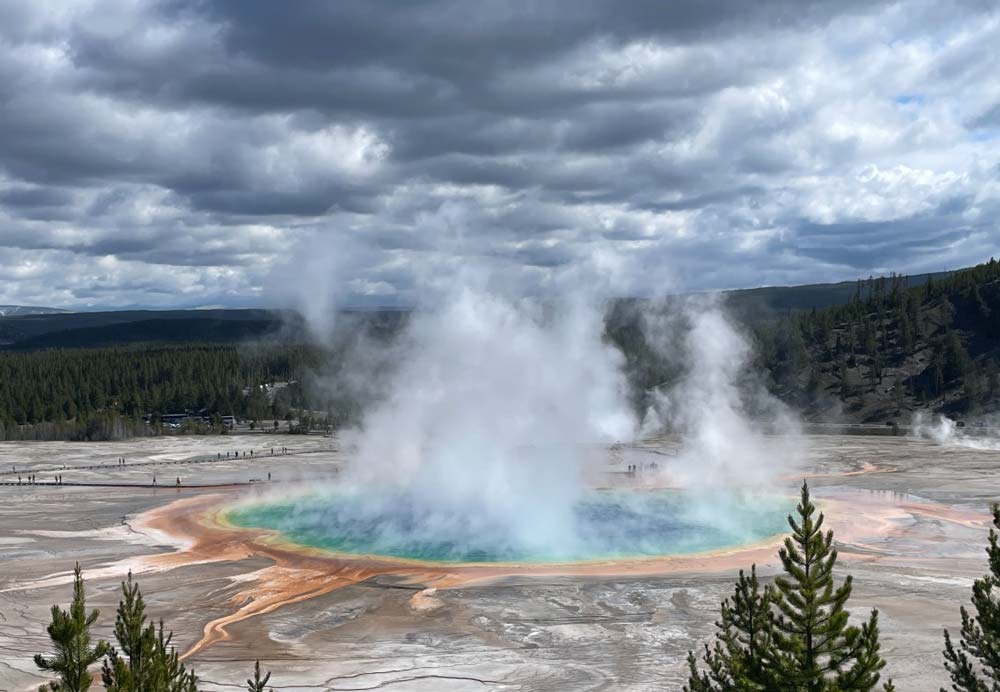Nestled in the heart of the United States, Yellowstone National Park is a treasure trove of natural wonders. Spanning an impressive 3,472 square miles across Wyoming, Montana, and Idaho, Yellowstone has the distinction of being the world’s first national park, established in 1872. The park boasts a breathtaking array of landmarks, from awe-inspiring geothermal features like Old Faithful and Grand Prismatic Spring to dramatic canyons, pristine alpine rivers, and vibrant forests. Its diverse ecosystem is home to iconic wildlife, such as grazing bison, roaming black and grizzly bears, howling wolves, and soaring bald eagles, providing an unparalleled experience for nature enthusiasts.
A key feature of Yellowstone is its Grand Loop Road, a meticulously planned route that connects the park’s major attractions and offers easy access for visitors. Whether you’re a first-time traveler or a seasoned explorer, Yellowstone’s pristine beauty and geological marvels promise a once-in-a-lifetime adventure. In this 3-day itinerary, you’ll journey through the park’s South and North Loops, uncovering everything from geysers and waterfalls to wildlife-filled valleys and historic landmarks.
Day 1: Exploring the South Loop – A Wonderland of Geysers, Waterfalls, and Yellowstone Lake
Morning: Geyser Wonderland
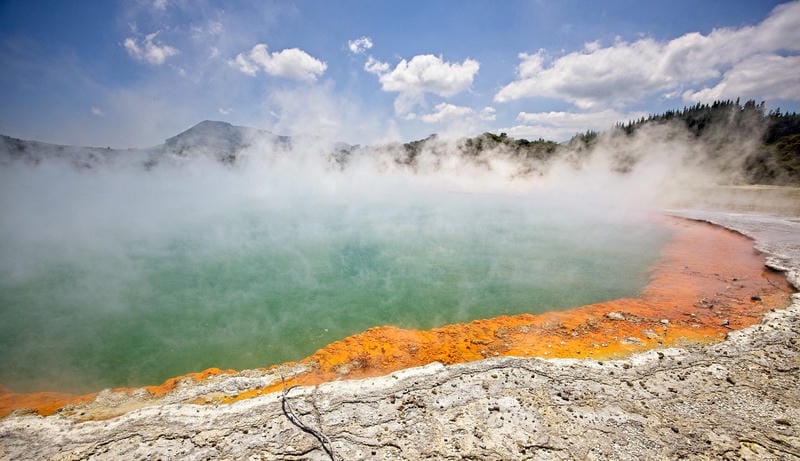
Kick-start your Yellowstone adventure by immersing yourself in the park’s world-famous geothermal activity. Begin your day early with a visit to Old Faithful, the quintessential Yellowstone attraction. This iconic geyser erupts approximately every 90 minutes, jetting water up to 180 feet in the air. Arrive in the morning to beat the crowds and capture stunning photographs of its powerful eruption. Stroll through the nearby Upper Geyser Basin to discover other remarkable geothermal features like Castle Geyser and Beehive Geyser.
Next, make your way to Grand Prismatic Spring, the largest hot spring in the United States. Renowned for its vivid, rainbow-like colors created by heat-loving microbes, this natural wonder is best viewed from the Fairy Falls Trail overlook, which offers a bird’s-eye perspective of the spring’s swirling hues. Nearby lies the Midway Geyser Basin, home to Excelsior Geyser Crater and its boiling waters flowing into Firehole River. Walk along the boardwalk trails for an up-close view of vibrant thermal pools.
Afternoon: Scenic Drives and Hidden Gems
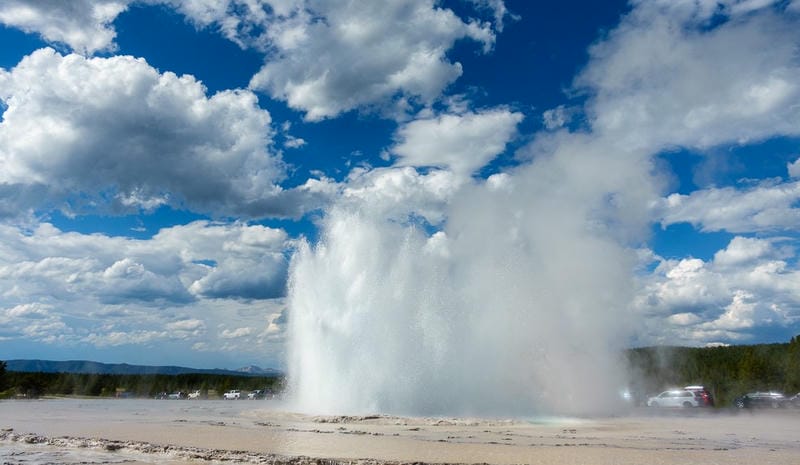
After an exhilarating morning, take a leisurely drive along Firehole Lake Drive, a scenic route showcasing geysers like the spectacular Great Fountain Geyser and White Dome Geyser. This short, looped road offers an opportunity to witness erupting geysers with minimal hiking.
Continue your adventure with a stop at Gibbon Falls, a picturesque 84-foot waterfall nestled along the Grand Loop Road. The overlook offers a perfect vantage point for photos and a chance to stretch your legs. From there, take a short hike to the Artist Paint Pots, a colorful geothermal area featuring bubbling mud pots and steaming fumaroles. The surreal landscape makes this one of Yellowstone’s hidden gems.
Evening: Unwinding by Yellowstone Lake
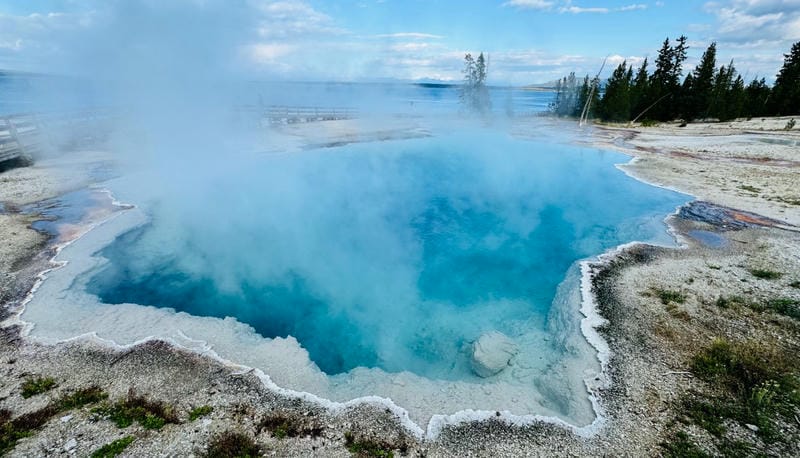
As the day winds down, head to the serene shores of Yellowstone Lake, North America’s largest high-elevation lake. Explore the West Thumb Geyser Basin, a magical area where geothermal features meet the tranquil waters of the lake. Stroll along the boardwalk to admire bubbling hot springs, steaming fumaroles, and colorful pools right on the lake’s edge.
Cap off your day with dinner at Grant Village, which offers cozy dining options with scenic lake views. Alternatively, enjoy a picnic by the lakeshore while keeping an eye out for wildlife such as otters, bald eagles, and elk. As the sun sets, soak in the peaceful ambiance, and prepare yourself for the adventures that await on Day 2.
Day 2: The Grand Canyon of Yellowstone and Wildlife Safari
Morning: Discovering the Grand Canyon of Yellowstone
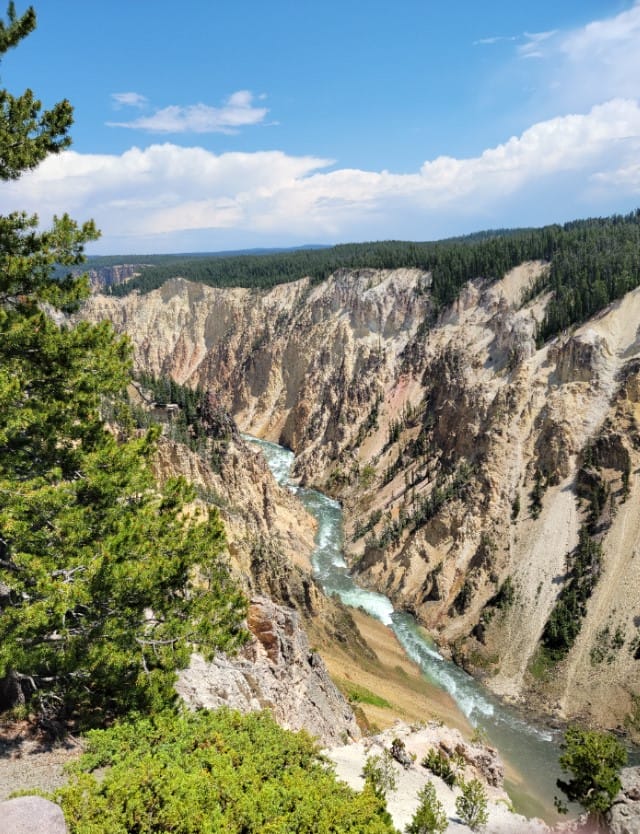
Day 2 begins with a visit to the breathtaking Grand Canyon of Yellowstone, a natural masterpiece carved by the Yellowstone River. This magnificent canyon, known for its vibrant yellow, orange, and red walls, is a must-see highlight of the park. Start at Artist Point, a famous viewpoint offering iconic views of the dramatic Lower Falls, which plunge 308 feet into the canyon below.
From there, head to Inspiration Point, another panoramic overlook providing stunning perspectives of the canyon’s rugged terrain and meandering river. For those who love a bit of adventure, hike the Brink of Lower Falls Trail, a steep but rewarding path that leads to a close-up view of the roaring waterfall. Along the way, you’ll learn about the geological history of the canyon, shaped by volcanic activity and millennia of erosion.
Afternoon: Wildlife Watching in Hayden Valley
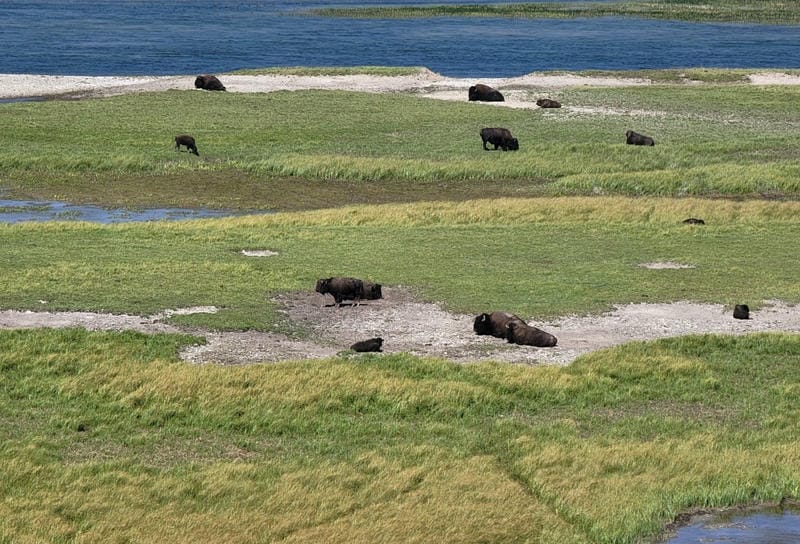
After exploring the canyon, make your way to Hayden Valley, one of the best spots in Yellowstone for wildlife watching. This sprawling valley is home to bison herds, elk, grizzly bears, and an array of bird species. Scan the open grasslands with binoculars to spot these magnificent creatures in their natural habitat.
The best time for wildlife viewing in Hayden Valley is early afternoon. Keep a respectful distance from animals—25 yards for most wildlife and at least 100 yards for bears and wolves—and follow all safety guidelines to ensure both your safety and theirs. As you absorb the raw beauty of the valley, you’ll understand why Yellowstone is often called a haven for wildlife enthusiasts.
Evening: Exploring Norris Geyser Basin
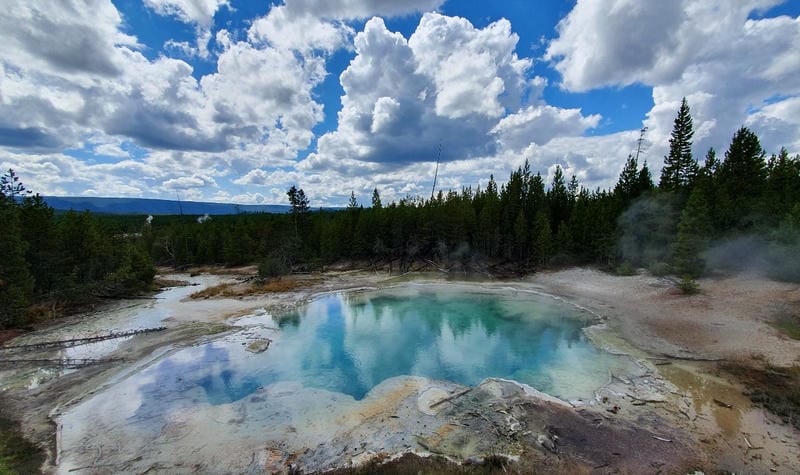
End Day 2 with a visit to Norris Geyser Basin, the hottest and most dynamic geothermal area in Yellowstone. This basin is home to the Steamboat Geyser, the tallest active geyser in the world, capable of erupting up to 300 feet high. Though eruptions are unpredictable, the steamy, otherworldly atmosphere alone is worth the trip.
Wander through Porcelain Basin, a surreal landscape filled with colorful hot springs, steaming fumaroles, and bubbling geysers. The boardwalk trails offer an easy way to explore this fascinating area while marveling at Yellowstone’s geothermal power. As night falls, return to your lodging or campsite and savor the memories of a day filled with awe-inspiring landscapes.
Day 3: Northern Highlights and Lamar Valley
Morning: Mammoth Hot Springs
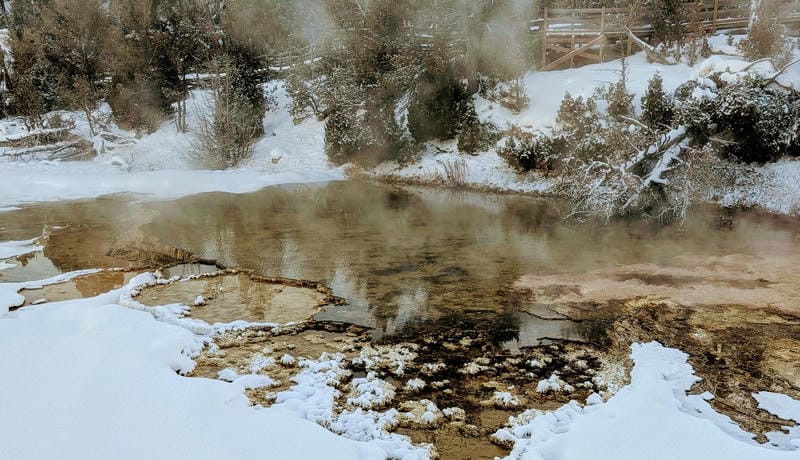
Begin your third day at the extraordinary Mammoth Hot Springs, a unique geological phenomenon located near the park’s North Entrance. This area is renowned for its striking travertine terraces, formed by hot water bubbling through limestone and creating cascading steps of white, orange, and yellow. Notable features include Liberty Cap, a dormant hot spring cone, and Minerva Terrace, celebrated for its dynamic, ever-changing landscape.
Stroll along the well-maintained boardwalks that wind their way through the terraces, offering stunning views of the formations and the surrounding mountains. Don’t miss the chance to visit the nearby Fort Yellowstone Historic District, a collection of 19th-century buildings that tell the story of the park’s early days. Stop by the Albright Visitor Center, where you can learn about Yellowstone’s cultural history, wildlife, and geothermal activity through interactive exhibits.
Afternoon: Lamar Valley Wildlife Adventure
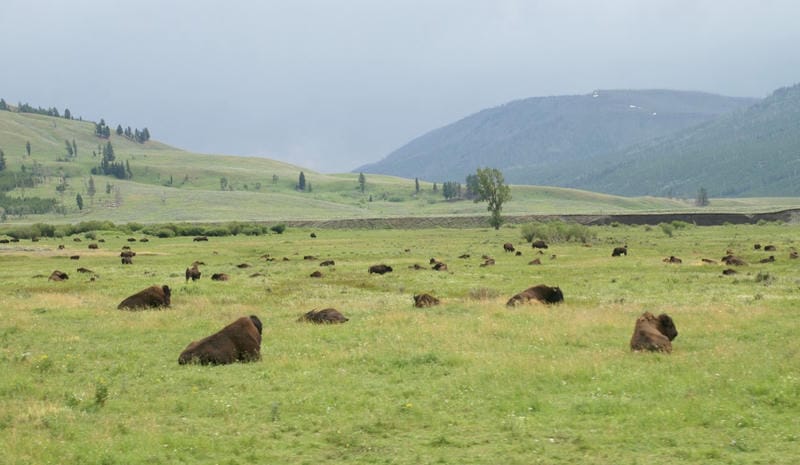
Next, embark on a journey to Lamar Valley, often hailed as “America’s Serengeti” for its abundance of wildlife. This expansive valley in the park’s northeastern region is a prime spot for spotting wolves, bison, elk, pronghorn antelope, and coyotes. The best times for wildlife viewing are at sunrise or sunset, when animals are most active.
Bring binoculars or a spotting scope for a closer look at the valley’s inhabitants, and take time to appreciate the serene beauty of this remote corner of the park. If you’re lucky, you may even catch a glimpse of a wolf pack prowling through the grasslands, an experience that is sure to leave a lasting impression.
Evening: Tower-Roosevelt Area
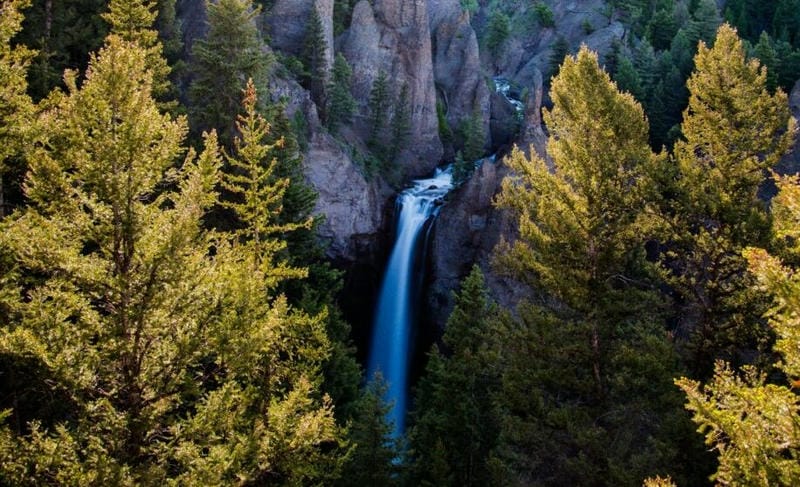
Wrap up your Yellowstone adventure in the Tower-Roosevelt area, a region known for its rugged beauty and historical significance. Visit Tower Fall, a 132-foot waterfall surrounded by towering rock spires, for a final dose of Yellowstone’s stunning scenery. From there, stroll to the Calcite Springs Overlook, which provides breathtaking views of the Yellowstone River winding through a canyon adorned with hydrothermal features.
For those seeking a bit of adventure, consider booking a horseback riding excursion or a guided tour to further explore the area. As the day comes to a close, reflect on the incredible diversity and majesty you’ve witnessed over the past three days.
Practical Tips for Your Yellowstone Trip
Best Time to Visit Yellowstone National Park
Yellowstone offers unique experiences year-round, but timing your visit can enhance your trip:
- Spring (April-May): Wildlife emerges from hibernation, and the park is less crowded. Be prepared for cooler weather and some road closures.
- Summer (June-August): The park is fully accessible, and all facilities are open. However, visitor numbers peak during this time, so plan for early starts.
- Fall (September-October): Enjoy vibrant autumn colors, cooler temperatures, and fewer crowds. Wildlife is also very active during this season.
- Winter (November-March): Though access is limited, winter transforms the park into a snowy wonderland. Activities like snowshoeing, cross-country skiing, and snowcoach tours offer unique ways to experience Yellowstone.
Where to Stay During Your Visit
Yellowstone offers a variety of accommodations, both inside and outside the park:
- Inside the Park: Stay close to key attractions at lodges like Old Faithful Inn, Canyon Lodge, or Mammoth Hot Springs Hotel. Note that accommodations fill up quickly, so book well in advance.
- Nearby Towns: Base yourself in nearby towns like West Yellowstone, located just outside the West Entrance, or Gardiner, near the North Entrance. These towns offer a range of lodging options, from budget-friendly motels to cozy cabins.
Transportation and Navigation Tips
- Rent a Car: Public transportation is not available in Yellowstone, so renting a car is essential. This gives you the flexibility to explore at your own pace.
- Offline Maps: Cell service is limited in the park, so download offline maps or bring a GPS device to navigate the Grand Loop Road and surrounding areas.
- Gas Up: Fuel stations are limited within the park, so ensure your tank is full before embarking on long drives.
FAQs About Visiting Yellowstone National Park in 3 Days
1. What is the best entrance to use for a 3-day visit?
The entrance you choose depends on your starting location and itinerary. The West Entrance at West Yellowstone is ideal for accessing the South Loop, while the North Entrance at Gardiner is perfect for the northern highlights.
2. How much does it cost to enter Yellowstone?
It costs $35 per vehicle for a seven-day pass. Alternatively, you can purchase an annual pass for $80, which provides access to all U.S. national parks.
3. What wildlife can I expect to see?
Yellowstone is teeming with wildlife, including bison, elk, grizzly and black bears, wolves, and coyotes. The best places for wildlife viewing are Hayden Valley and Lamar Valley, especially during early mornings and late evenings.
4. Are there any safety tips I should follow?
- Maintain safe distances from animals: at least 25 yards from most wildlife and 100 yards from bears and wolves.
- Carry bear spray if hiking, and know how to use it.
- Stay on marked trails, especially in geothermal areas, to avoid injury from scalding water or unstable ground.
5. Is Yellowstone accessible in the winter?
Yes! Though some roads close due to snow, visitors can still explore the park via guided snowcoach tours, snowmobiles, and cross-country skiing or snowshoeing. Winter offers a serene and magical view of Yellowstone’s landscapes.
Conclusion
Yellowstone National Park is more than just a destination—it’s a living testament to the power and beauty of nature. Over the course of three days, you can immerse yourself in the park’s geothermal phenomena, breathtaking landscapes, and diverse wildlife. From the iconic eruptions of Old Faithful to the colorful splendor of the Grand Prismatic Spring, from the towering waterfalls of the Grand Canyon of Yellowstone to the wildlife-rich valleys of Hayden and Lamar, Yellowstone offers an experience that is as enriching as it is awe-inspiring.
This 3-day itinerary is a perfect balance of exploration and relaxation, ensuring you can fully appreciate the park’s highlights while leaving room for spontaneous moments of wonder. Whether you’re walking along the serene shores of Yellowstone Lake, locking eyes with a bison in the valleys, or witnessing the earth’s geothermal forces up close, every corner of Yellowstone holds something magical.
As you plan your journey, remember to respect the park’s wildlife and natural features, ensuring this pristine environment can be enjoyed by future generations. Yellowstone’s timeless beauty and boundless adventure opportunities make it a destination that will forever hold a special place in your heart. So pack your bags, bring your sense of wonder, and embark on an unforgettable journey through one of the world’s greatest natural wonders. Yellowstone awaits!
